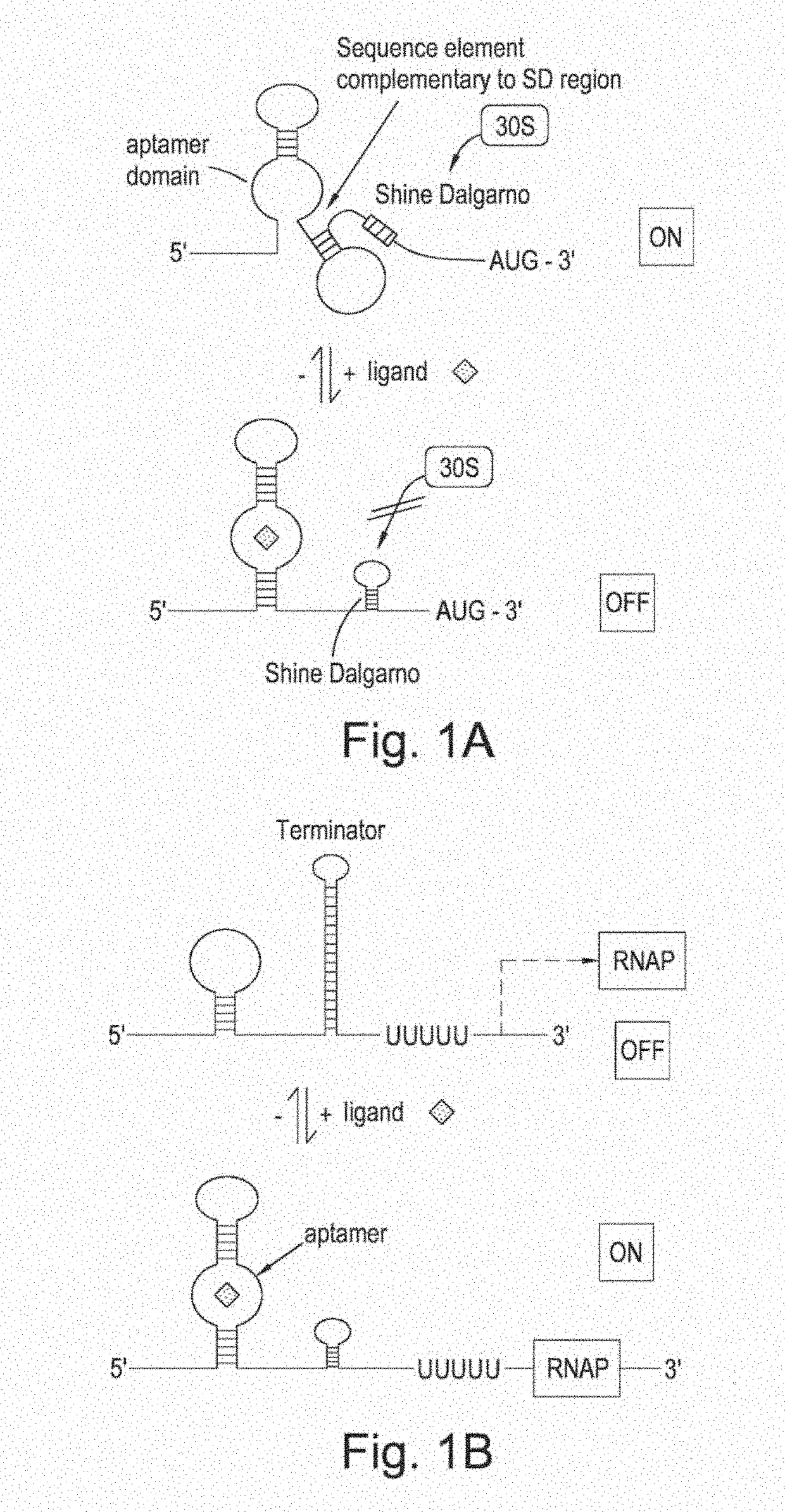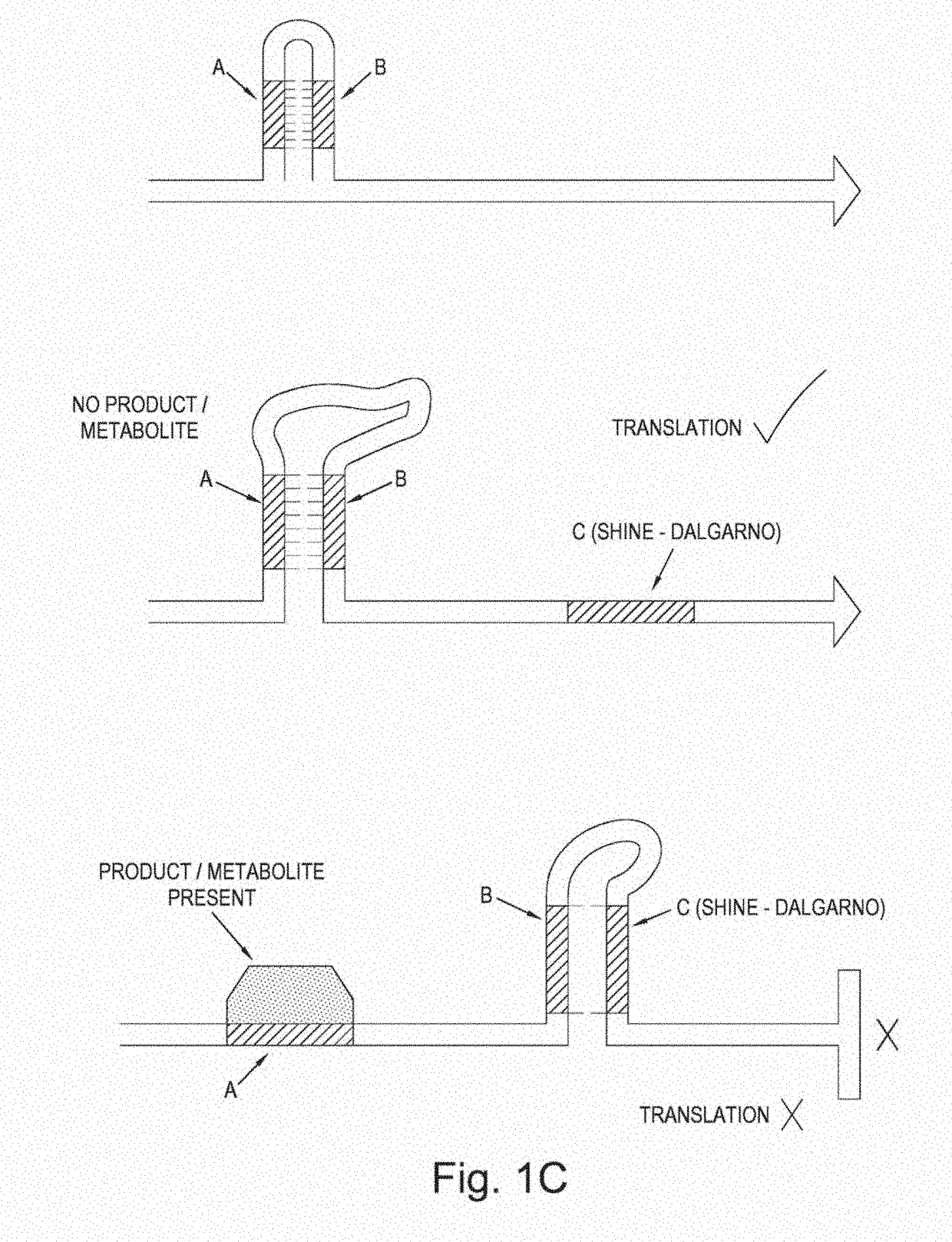Riboswitch inducible gene expression
a gene expression and riboswitch technology, applied in the field of cell biology, molecular genetics and genetic engineering, can solve the problems of low common gene expression systems continue to suffer drawbacks, and high basal (i.e. uninduced) expression levels
- Summary
- Abstract
- Description
- Claims
- Application Information
AI Technical Summary
Benefits of technology
Problems solved by technology
Method used
Image
Examples
example 1
Evaluation of T4 Intron-Controlled ThyA Auxotrophy
[0111]An in vivo biosensor is usually composed of a control element and a reporter gene. The reporter gene can confer antibiotic resistance, fluorescence, auxotrophy complementation or luminescence. The control element can act on several stages in the protein production process. Protein based control elements like LacI typically intervene with the transcription of the gene, while inteins and post-translational modification deal with activation of the protein itself. In between, there is the control on translational level predominantly performed by riboswitches. The riboswitches are mostly located in the 5′-UTR sequestering and releasing the Shine-Dalgarno sequence to block or allow translation by the ribosome. For example, FIG. 1 shows the operation of a generalised riboswitch, illustrating how structural changes in the RNA fragment induced by the binding of a signal metabolite may result in the reduced accessibility of the Shine-Dal...
example 2
Introduction of a Second Intron Into the thyA Coding Sequence
[0125]The strong promoters PtacI and Ptet showed leakage exceeding the minimal requirement of ThyA (FIG. 4). A second intron was introduced into the coding region of thyA. No other part of the thyA gene matches the native flanking regions of the phage T4 td intron, so another strategy was applied. The absence of an easily identified insertion site presents a challenge as the intron ribozyme is composed not only of the intron region itself, but of the 3′ flank of exon 1 and the 5′ flank of exon 2 as well. The intron flanks are therefore part of both the ribozyme and the coding region (FIG. 5).
[0126]Previously, Pichler et al. (Pichler and Schroeder, 2002, J Biol Chem 277:17987-17993) showed that the flanking sequence does not need to match the native flanking sequence perfectly for a functional phage T4 td intron. Next to some tolerance in the intron flanking regions, the coding sequence can be composed of different codons. ...
example 3
Development of a Synthetic Riboswitch-Ribozyme Hybrid
[0149]Group I self-splicing introns are RNA molecules with catalytic activity: i.e. RNA ribozymes. These introns catalyze their own excision from precursors such as mRNA. The well characterized T4 self-splicing intron has been demonstrated to adopt a specific 3D-structure that is required for catalytic activity (FIG. 8). In loop 6a, sequences have been inserted that affect the splicing activity. Insertion of ligand-binding RNA fragments (aptamers) controls the splicing by a conformational change, triggered by the presence or absence of a specific ligand.
[0150]The T4 self-splicing intron has been engineered into a functional catalytic riboswitch by inserting a theophylline-binding aptamer (FIG. 5). The recombinant riboswitch was still able to splice itself, but its cleavage activity was triggered by a conformational change upon binding of the aptamer ligand, i.e. theophylline (Thompson et al, 2002 BMC Biotechnol. 2: 21). The molecu...
PUM
| Property | Measurement | Unit |
|---|---|---|
| Affinity | aaaaa | aaaaa |
Abstract
Description
Claims
Application Information
 Login to View More
Login to View More - R&D
- Intellectual Property
- Life Sciences
- Materials
- Tech Scout
- Unparalleled Data Quality
- Higher Quality Content
- 60% Fewer Hallucinations
Browse by: Latest US Patents, China's latest patents, Technical Efficacy Thesaurus, Application Domain, Technology Topic, Popular Technical Reports.
© 2025 PatSnap. All rights reserved.Legal|Privacy policy|Modern Slavery Act Transparency Statement|Sitemap|About US| Contact US: help@patsnap.com



